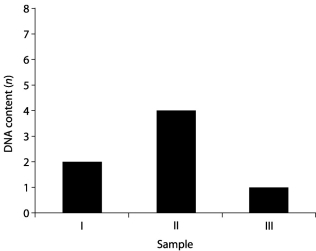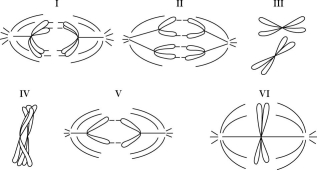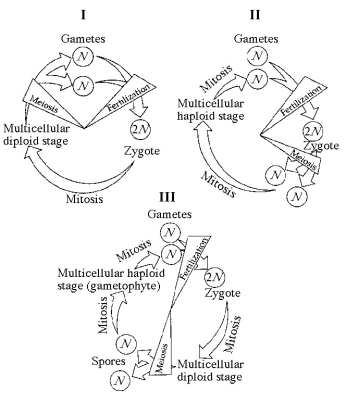A) sister chromatids grouped at the poles
B) individual chromosomes all at the cell's center
C) an uninterrupted spindle array
D) the synaptonemal complex
E) tetrads all aligned at the cell's center
Correct Answer

verified
Correct Answer
verified
Multiple Choice
Refer to the following information and Figure 13.4 to answer the following questions.
A certain (hypothetical) organism is diploid, has either blue or orange wings as the consequence of one of its genes on chromosome 12, and has either long or short antennae as the result of a second gene on chromosome 19, as shown in Figure 13.4.
 Figure 13.4
-A certain female's number 12 chromosomes both have the blue gene and number 19 chromosomes both have the long gene. As cells in her ovaries undergo meiosis, her resulting eggs (ova) may have which of the following?
Figure 13.4
-A certain female's number 12 chromosomes both have the blue gene and number 19 chromosomes both have the long gene. As cells in her ovaries undergo meiosis, her resulting eggs (ova) may have which of the following?
A) either two number 12 chromosomes with blue genes or two with orange genes
B) either two number 19 chromosomes with long genes or two with short genes
C) either one blue or one orange gene in addition to either one long or one short gene
D) one chromosome 12 with one blue gene and one chromosome 19 with one long gene
Correct Answer

verified
Correct Answer
verified
Multiple Choice
You have isolated DNA from three different cell types of an organism, determined the relative DNA content for each type, and plotted the results on the graph shown in Figure 13.3. Refer to the graph to answer the following questions.
 Figure 13.3
-Which sample of DNA might be from a nerve cell arrested in G₀ of the cell cycle?
Figure 13.3
-Which sample of DNA might be from a nerve cell arrested in G₀ of the cell cycle?
A) I
B) II
C) III
D) either I or II
E) either I or III
Correct Answer

verified
Correct Answer
verified
Multiple Choice
If the DNA content of a diploid cell in the G₁ phase of the cell cycle is x, then the DNA content of the same cell at metaphase of meiosis I would be
A) 0.25x.
B) 0.5x.
C) x.
D) 2x.
E) 4x.
Correct Answer

verified
Correct Answer
verified
Multiple Choice
You have isolated DNA from three different cell types of an organism, determined the relative DNA content for each type, and plotted the results on the graph shown in Figure 13.3. Refer to the graph to answer the following questions.
 Figure 13.3
-Which sample might represent an animal cell in the G₂ phase of the cell cycle?
Figure 13.3
-Which sample might represent an animal cell in the G₂ phase of the cell cycle?
A) I
B) II
C) III
D) both I and II
E) either II or III
Correct Answer

verified
Correct Answer
verified
Multiple Choice
Meiosis II is similar to mitosis in that
A) sister chromatids separate during anaphase.
B) DNA replicates before the division.
C) the daughter cells are diploid.
D) homologous chromosomes synapse.
E) the chromosome number is reduced.
Correct Answer

verified
Correct Answer
verified
Multiple Choice
At which stage of mitosis are chromosomes usually photographed in the preparation of a karyotype?
A) prophase
B) metaphase
C) anaphase
D) telophase
E) interphase
Correct Answer

verified
B
Correct Answer
verified
Multiple Choice
For the following questions, match the key event of meiosis with the stages listed below. I. Prophase I V. Prophase II II. Metaphase I VI. Metaphase II III. Anaphase I VII. Anaphase II IV. Telophase I VIII. Telophase II -Synaptonemal complexes form or are still present.
A) I only
B) I and IV only
C) I and VIII only
D) II and VI only
E) I, II, III, and IV only
Correct Answer

verified
Correct Answer
verified
Multiple Choice
Experiments with cohesins have found that
A) cohesins are protected from destruction throughout meiosis I and II.
B) cohesins are cleaved from chromosomes at the centromere before anaphase I.
C) cohesins are protected from cleavage at the centromere during meiosis I.
D) a protein cleaves cohesins before metaphase I.
E) a protein that cleaves cohesins would cause cellular death.
Correct Answer

verified
Correct Answer
verified
Multiple Choice
To view and analyze human chromosomes in a dividing cell, which of the following is/are required?
A) electron microscope
B) radioactive staining
C) fluorescent staining
D) DNA stain and a light microscope
E) a stain particular to human cells
Correct Answer

verified
D
Correct Answer
verified
Multiple Choice
Refer to the drawings in Figure 13.2 of a single pair of homologous chromosomes as they might appear during various stages of either mitosis or meiosis, and answer the following questions.
 Figure 13.2
-Which diagram(s) represent anaphase II of meiosis?
Figure 13.2
-Which diagram(s) represent anaphase II of meiosis?
A) II only
B) III only
C) IV only
D) V only
E) either II or V
Correct Answer

verified
Correct Answer
verified
Multiple Choice
When we see chiasmata under a microscope, that lets us know which of the following has occurred?
A) asexual reproduction
B) meiosis II
C) anaphase II
D) prophase I
E) separation of homologs
Correct Answer

verified
Correct Answer
verified
Multiple Choice
Refer to the life cycles illustrated in Figure 13.1 to answer the following questions.
 Figure 13.1
-Which of the life cycles is typical for plants and some algae?
Figure 13.1
-Which of the life cycles is typical for plants and some algae?
A) I only
B) II only
C) III only
D) I and II
E) I and III
Correct Answer

verified
Correct Answer
verified
Multiple Choice
For the following questions, match the key event of meiosis with the stages listed below. I. Prophase I V. Prophase II II. Metaphase I VI. Metaphase II III. Anaphase I VII. Anaphase II IV. Telophase I VIII. Telophase II -Tetrads of chromosomes are aligned at the equator of the spindle; alignment determines independent assortment.
A) I
B) II
C) IV
D) VI
E) VIII
Correct Answer

verified
Correct Answer
verified
Multiple Choice
Which of the following can utilize both mitosis and meiosis in the correct circumstances?
A) a haploid animal cell
B) a diploid cell from a plant stem
C) any diploid animal cell
D) a plantlike protist
E) an archaebacterium
Correct Answer

verified
Correct Answer
verified
Multiple Choice
For the following questions, match the key event of meiosis with the stages listed below. I. Prophase I V. Prophase II II. Metaphase I VI. Metaphase II III. Anaphase I VII. Anaphase II IV. Telophase I VIII. Telophase II -Centromeres of sister chromatids disjoin and chromatids separate.
A) II
B) III
C) IV
D) V
E) VII
Correct Answer

verified
E
Correct Answer
verified
Multiple Choice
Which of the following is a true statement about sexual vs. asexual reproduction?
A) Asexual reproduction, but not sexual reproduction, is characteristic of plants and fungi.
B) In sexual reproduction, individuals transmit 50% of their genes to each of their offspring.
C) In asexual reproduction, offspring are produced by fertilization without meiosis.
D) Sexual reproduction requires that parents be diploid.
E) Asexual reproduction produces only haploid offspring.
Correct Answer

verified
Correct Answer
verified
Multiple Choice
In a human karyotype, chromosomes are arranged in 23 pairs. If we choose one of these pairs, such as pair 14, which of the following do the two chromosomes of the pair have in common?
A) Length and position of the centromere only.
B) Length, centromere position, and staining pattern only.
C) Length, centromere position, staining pattern, and traits coded for by their genes.
D) Length, centromere position, staining pattern, and DNA sequences.
E) They have nothing in common except they are X-shaped.
Correct Answer

verified
Correct Answer
verified
Multiple Choice
Use the following information to answer the next questions. There is a group of invertebrate animals called rotifers, among which a particular group of species reproduces, as far as is known, only asexually. These rotifers, however, have survived a long evolutionary history without evidence of having been overcome by excessive mutations. -In these asexual rotifers, how does variation occur without meiosis and fertilization?
A) The rotifers have evolved a different mechanism to exchange DNA.
B) Rotifers must produce haploid spores.
C) Variation is caused by mutation and maintained by selection.
D) Some rotifers must selectively lose chromosomes.
E) Rotifers must live only in specialized environments.
Correct Answer

verified
Correct Answer
verified
Multiple Choice
A tetrad includes which of the following sets of DNA strands?
A) two single-stranded chromosomes that have synapsed
B) two sets of sister chromatids that have synapsed
C) four sets of sister chromatids
D) four sets of unique chromosomes
E) eight sets of sister chromatids
Correct Answer

verified
Correct Answer
verified
Showing 1 - 20 of 70
Related Exams